BEST Homemade Margherita Pizza

This recipe is basically the cheat code for making restaurant-quality pizza in your regular home oven – no fancy wood-fired setup required.
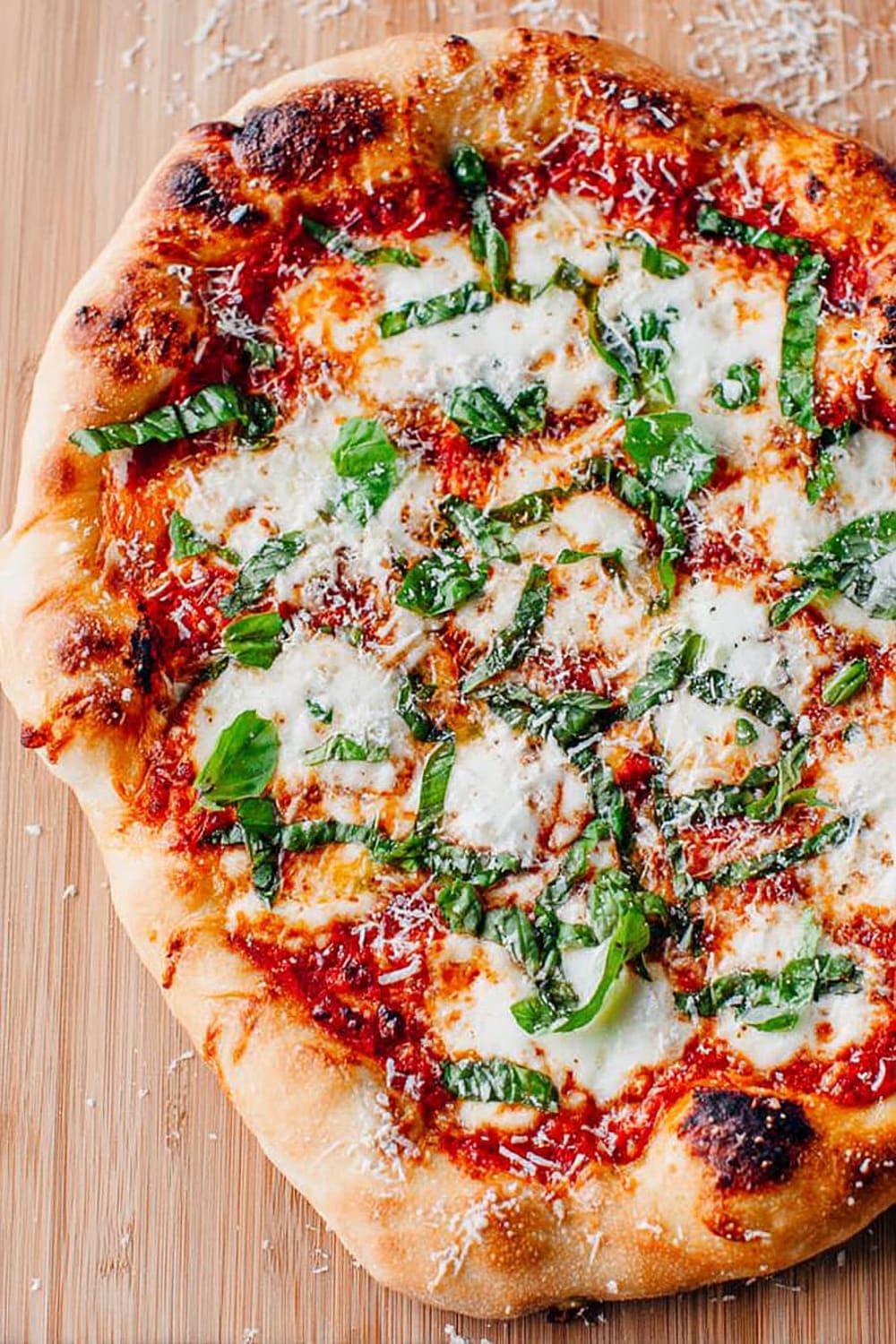
The combination of San Marzano tomatoes, fresh mozzarella, and aromatic basil creates that perfect trifecta of flavors that’ll have you questioning why you ever ordered delivery.
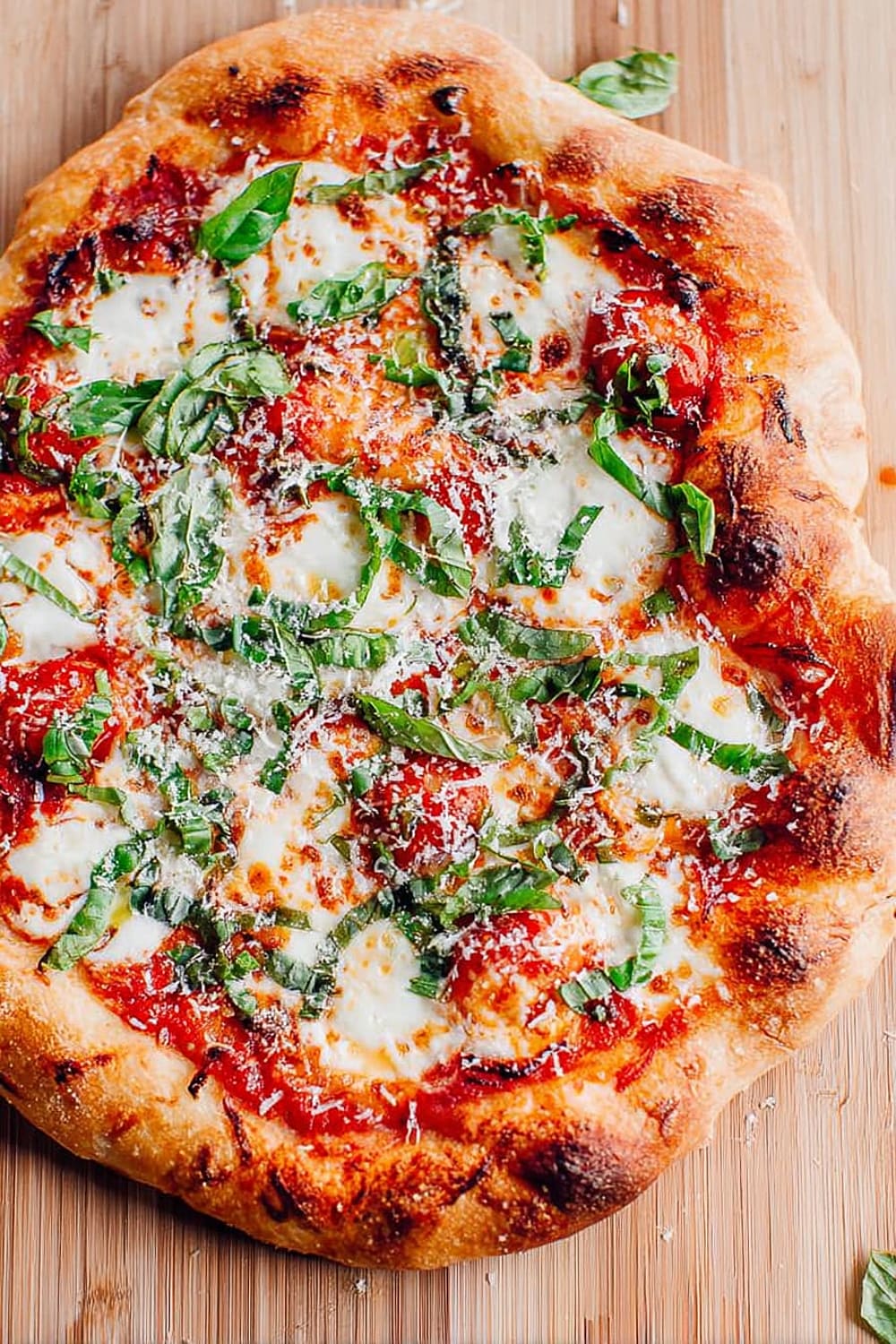
What makes this margherita pizza truly special is the homemade dough that develops incredible flavor during its 2-hour rise, creating those coveted chewy-yet-crispy edges.

The secret weapon here is preheating your baking steel or pizza stone to a blazing 550°F (285°C) for a full hour – this mimics the intense heat of professional pizza ovens.
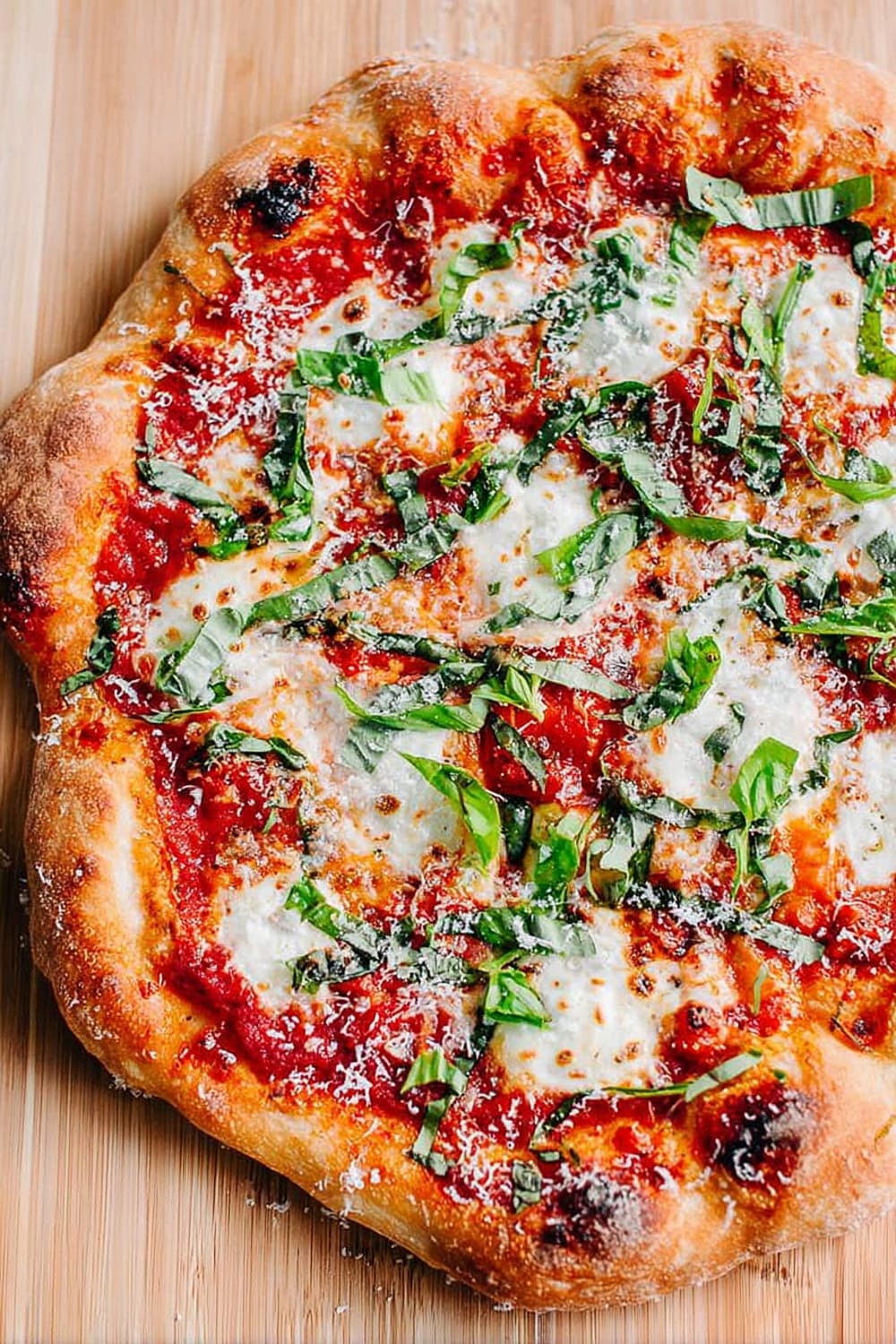
You’ll be amazed how the cheese bubbles and caramelizes while the crust develops those beautiful golden-brown spots that scream “I know what I’m doing in the kitchen.”

Prepare yourself for the ultimate compliment when people ask if you secretly trained in Italy – nope, just followed this foolproof recipe that works every single time.
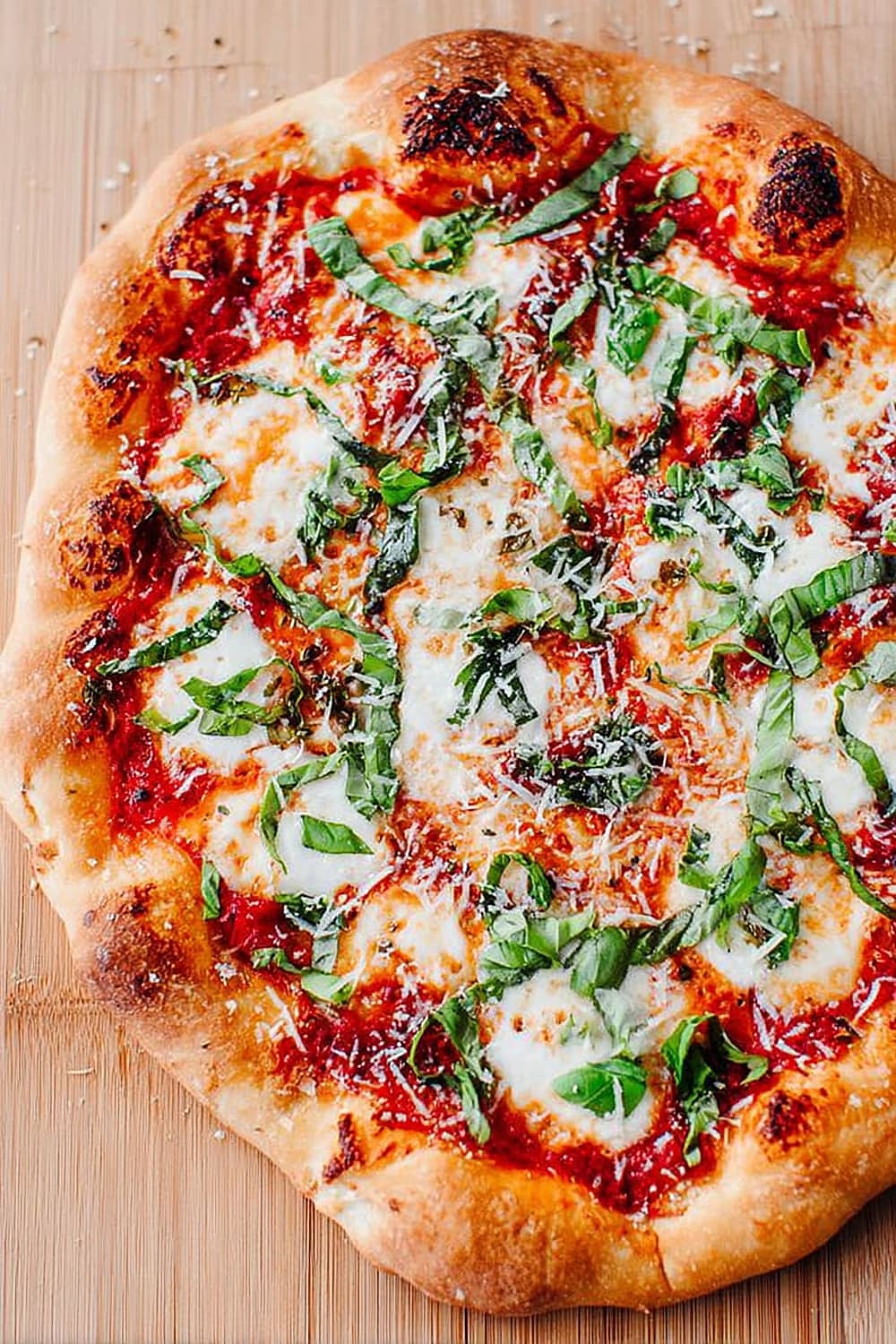
Ingredients
For the Homemade Pizza Dough
- 2½ cups (300g) unbleached all-purpose flour
- 1 teaspoon granulated sugar
- ½ teaspoon active dry yeast or SAF instant yeast
- ¾ teaspoon kosher salt
- 7 ounces warm water (105°F to 115°F)
- 1 tablespoon extra virgin olive oil
- Semolina and all-purpose flour for dusting the pizza peel
For the Pizza Sauce
- 1 cup pureed or crushed canned San Marzano tomatoes (or canned Italian plum tomatoes)
- 2-3 fresh garlic cloves grated with a microplane or pressed
- 1 teaspoon extra virgin olive oil plus more for drizzling
- 2-3 large pinches of kosher salt to taste
- ¼ teaspoon freshly ground black pepper
For the Toppings
- 2-3 tablespoons finely grated parmigiano-reggiano cheese plus more for serving
- 7 ounces fresh mozzarella cheese (not packed in water) cut into ½-inch cubes
- 5-6 large fresh basil leaves plus more for garnishing
- Dried red pepper flakes (optional)
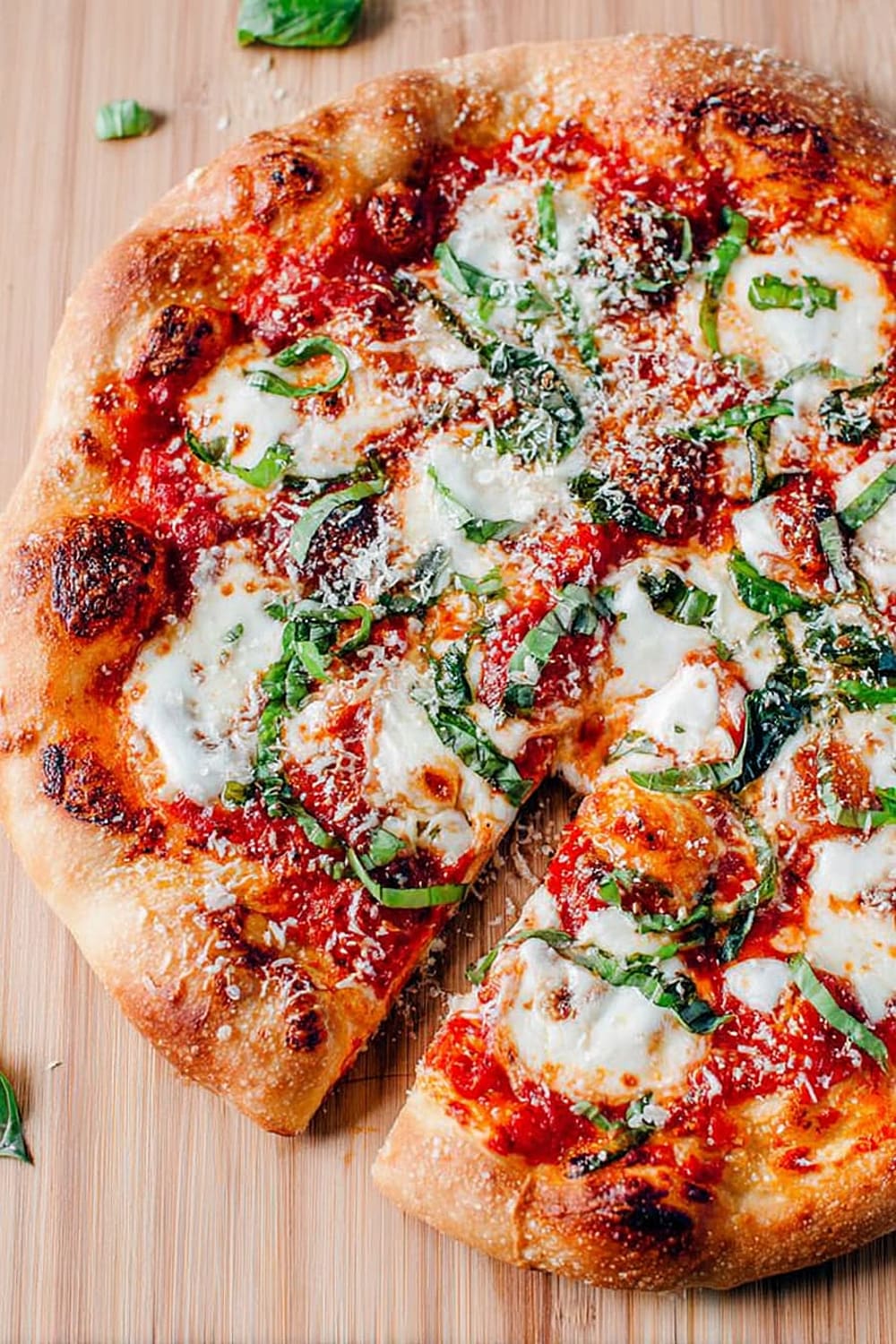
Instructions
Prepare the Pizza Dough
- 1 In a medium bowl, whisk together the all-purpose flour, sugar, yeast, and salt until evenly combined. Add the warm water (105°F to 115°F) and olive oil, then stir the mixture with a wooden spoon until the dough just begins to come together. Don’t worry if it seems shaggy and dry at this point – this is completely normal.
- 2 Scrape the dough onto a well-floured countertop and knead for 3 minutes until it transforms from shaggy to smooth. The dough should quickly come together and begin to get slightly sticky. Dust with flour as needed (usually 2-3 times depending on humidity levels) – aim for slightly tacky but not sticking to your countertop. After 3 minutes, the dough should be smooth, slightly elastic, and tacky to the touch.
- 3 Lightly grease a large mixing bowl with olive oil and place the dough inside. Cover with a kitchen towel or plastic wrap and allow to rise in a warm, dry area of your kitchen for 2 hours or until doubled in size. Pro tip: If your kitchen is cold, heat a large measuring cup of water in the microwave for 2-3 minutes, remove it, then place your dough bowl inside the warm microwave to create the perfect proofing environment.
Preheat and Prepare
- 4 Place your baking steel or pizza stone on the second-to-top rack of your oven (roughly 8 inches from the broiler element) and preheat to 550°F (285°C) for a minimum of 1 hour. If your oven doesn’t reach 550°F or you’re using a delicate pizza stone, heat to a maximum of 500°F (260°C). This extended preheating time is crucial for achieving that perfect crispy crust.
- 5 While the oven preheats, prepare your sauce by stirring together the pureed tomatoes, minced garlic, extra virgin olive oil, pepper, and salt in a small bowl. Set aside another bowl with the cubed mozzarella cheese, patting the cheese with paper towels to remove excess moisture. Arrange the basil leaves and grated parmigiano-reggiano for easy access during assembly.
Shape and Assemble
- 6 Divide the risen dough into two equal portions – it will deflate slightly, which is perfectly normal. Place on a large plate or floured countertop, cover gently with plastic wrap, and let rest for 5-10 minutes to relax the gluten.
- 7 Sprinkle your pizza peel generously with semolina and a dusting of all-purpose flour (if you don’t have a pizza peel, try the back of a half sheet pan, though it’s trickier). Using both hands, gently stretch one dough ball into roughly a 10-inch circle – don’t worry about perfect uniformity. If the dough springs back, let it rest another 5 minutes. The edges can be slightly thicker, but ensure the center is thin enough to see light through when held up.
- 8 Transfer the stretched dough onto your semolina-dusted pizza peel. Drizzle lightly with olive oil (about 1 teaspoon) and spread with your fingertips. Using a large spoon, add roughly ½ cup tomato sauce, leaving a ½-inch to ¾-inch border on all sides. Spread evenly and thinly with the back of the spoon.
Final Assembly and Baking
- 9 Sprinkle 1 tablespoon parmigiano-reggiano over the sauce, then distribute half the cubed mozzarella evenly across the pizza. Tear 2-3 large basil leaves by hand and sprinkle over the cheese. At this point, you can stretch the dough edges slightly thinner if needed.
- 10 Carefully slide the pizza from the peel onto the heated baking steel or stone. Bake for 7-8 minutes until the crust is golden, the cheese is bubbling and caramelized, and the edges are beautifully golden brown. For extra color, finish under the low or medium broil setting for 1-2 minutes, watching carefully to prevent burning.
- 11 Remove the pizza carefully with your pizza peel and transfer to a wooden cutting board. Immediately drizzle with extra virgin olive oil, sprinkle with additional parmigiano-reggiano, and garnish with fresh basil chiffonade. Slice and serve immediately while preparing the second pizza.

Recommended Equipment and Kitchen Tools
Essential Tools (for best results):
- Baking steel or pizza stone – Creates the intense bottom heat needed for crispy crusts that rival pizzeria ovens
- Pizza peel – Makes transferring pizzas safely and efficiently possible; wooden peels work best for raw dough
- Kitchen scale – Ensures consistent dough hydration and perfect ingredient ratios every time
- Instant-read thermometer – Critical for checking water temperature and oven accuracy
Helpful Upgrades:
- Stand mixer with dough hook – Takes the work out of kneading, though hand-kneading builds better intuition
- Microplane grater – Creates perfectly fine garlic and cheese that distributes evenly
- Bench scraper – Makes dividing dough and cleaning your workspace infinitely easier
- Semolina flour – Prevents sticking better than regular flour and adds authentic texture
Nice-to-Have Options:
- Parchment paper – Can substitute for a pizza peel in emergencies, though it may brown at high temperatures
- Large mixing bowls – Glass or stainless steel work best for dough rising and ingredient prep
- Silicone spatula – Perfect for scraping every bit of sauce from bowls and spreading oil evenly

Recipe Variations and Dietary Modifications
Gluten-Free Adaptation:
- Replace all-purpose flour with 2¾ cups gluten-free flour blend (one containing xanthan gum)
- Add 1 teaspoon xanthan gum if your flour blend doesn’t include it
- Expect a slightly denser texture and reduce kneading time to 1-2 minutes
- May need 2-3 tablespoons additional water for proper hydration
Dairy-Free Modifications:
- Substitute fresh mozzarella with dairy-free mozzarella shreds or cashew-based fresh mozzarella
- Replace parmigiano-reggiano with nutritional yeast or dairy-free parmesan alternative
- Use extra virgin olive oil instead of any butter-based toppings
Vegan Version:
- Follow dairy-free modifications above
- Ensure your sugar is vegan-certified (some use bone char processing)
- Add 1 tablespoon nutritional yeast to the dough for extra flavor depth
Sourdough Variation:
- Replace ½ cup flour and 3 ounces water with ¾ cup active sourdough starter
- Reduce yeast to ¼ teaspoon and increase rise time to 3-4 hours
- Results in more complex flavor and improved digestibility
Flavor Variations:
- White Pizza: Skip tomato sauce, brush with garlic olive oil, add ricotta dollops
- Spicy Version: Add red pepper flakes to sauce and hot honey drizzle after baking
- Herb-Infused: Mix dried oregano and Italian seasoning into the dough
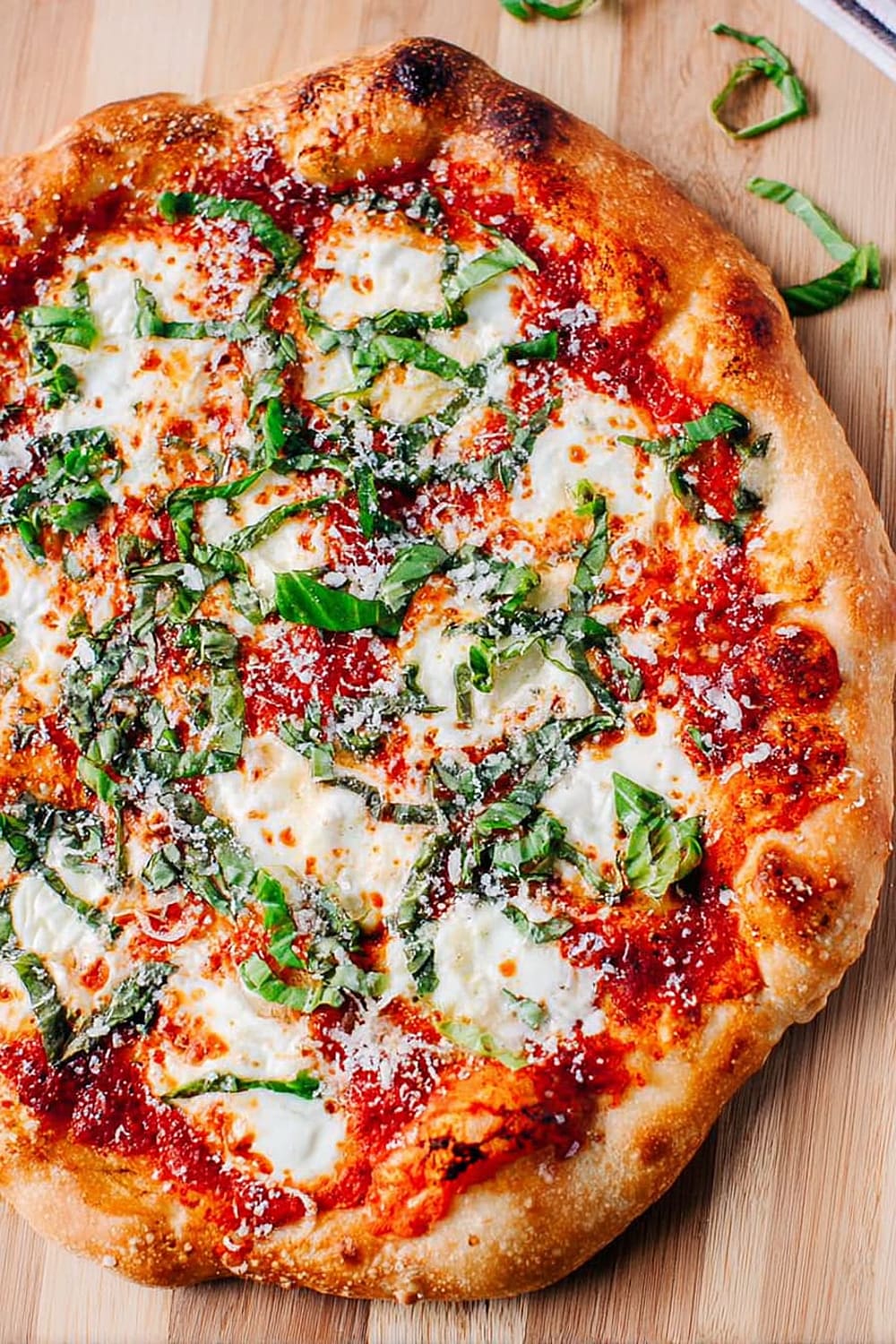
Nutritional Information and Health Benefits
Key Nutritional Highlights:
Each serving (½ pizza) contains approximately 520 calories with a balanced macronutrient profile of 65g carbohydrates, 18g protein, and 20g fat. The homemade dough provides complex carbohydrates and 4g fiber, while the fresh mozzarella contributes high-quality protein and calcium. San Marzano tomatoes add vitamin C and lycopene without excess sodium found in many commercial pizza sauces.
Health Benefits of Main Ingredients:
San Marzano tomatoes are rich in lycopene, a powerful antioxidant that becomes more bioavailable when cooked, supporting heart health and potentially reducing cancer risk. Fresh mozzarella provides calcium and phosphorus for bone health, plus complete proteins with all essential amino acids. Fresh basil contains vitamin K for bone health and eugenol, a compound with anti-inflammatory properties. Extra virgin olive oil delivers monounsaturated fats and antioxidants that support cardiovascular health.
Dietary Considerations:
This recipe contains gluten (wheat flour) and dairy (mozzarella, parmigiano-reggiano), making it unsuitable for those with celiac disease or dairy allergies. The 2-hour fermentation time partially breaks down gluten proteins, potentially improving digestibility for those with mild sensitivities. Each pizza provides a moderate sodium content of approximately 850mg, primarily from cheese and added salt.
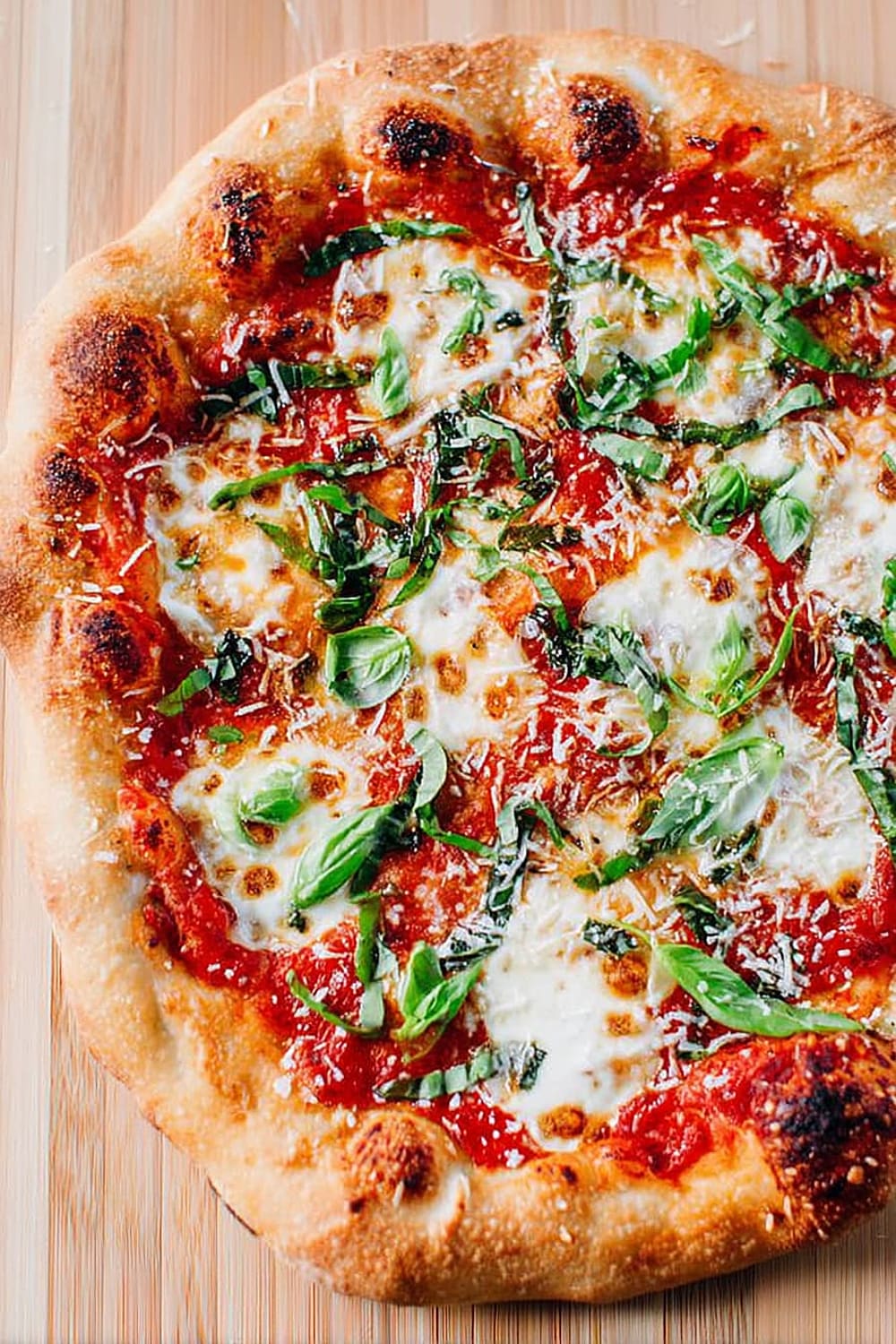
Smart Swaps and Ingredient Substitutions
Common Substitutions:
- San Marzano tomatoes → Muir Glen crushed tomatoes or Hunt’s whole tomatoes, crushed by hand
- Fresh mozzarella → Low-moisture mozzarella (use 25% less to prevent greasiness)
- Active dry yeast → Instant yeast (use same amount, no need to proof in warm water)
- Semolina flour → Cornmeal or additional all-purpose flour for dusting
Budget-Friendly Swaps:
- Parmigiano-reggiano → Pecorino Romano or aged Asiago (use same amounts)
- San Marzano tomatoes → Generic crushed tomatoes plus pinch of sugar to balance acidity
- Fresh basil → Dried basil (use 1 teaspoon dried for 6 fresh leaves)
Pantry Emergency Substitutions:
- Pizza stone/steel → Inverted sheet pan preheated in oven (won’t get as crispy but works)
- Pizza peel → Parchment paper on back of sheet pan (remove paper after transfer)
- Fresh garlic → ½ teaspoon garlic powder mixed into sauce
Pro Tips for Substitutions:
- Store leftover dough wrapped in plastic for 3 days refrigerated or 3 months frozen
- Substitute herbs work best when added after baking to preserve flavor
- Different cheeses may require temperature adjustments – harder cheeses need slightly lower heat

Make It Diabetes-Friendly
Flour & Carb Modifications:
- Replace 1 cup all-purpose flour with almond flour and ¼ cup vital wheat gluten to reduce carbs by approximately 30g per pizza
- Use cauliflower pizza crust as base to cut carbs from 65g to 15g per serving
- Make smaller 8-inch pizzas and pair with large salad to reduce portion size naturally
Sugar Substitutions:
- Eliminate 1 teaspoon sugar from dough (saves 4g carbs total) – dough will still rise effectively
- Choose no-sugar-added crushed tomatoes to avoid hidden sugars in sauce
- Replace any honey drizzles with sugar-free alternatives or extra herbs
Portion & Timing Tips:
- Stick to ¼ pizza servings (approximately 33g carbs) paired with protein-rich side salad
- Estimated carb content: 33g per quarter pizza vs 65g per half pizza
- Eat protein first (add grilled chicken or side of nuts) to slow glucose absorption
- Timing strategy: Enjoy as lunch rather than dinner for better glucose management
Total Carb Reduction: Modified version reduces carbs from 65g to 45g per serving with flour substitution, or 33g per serving with smaller portions.
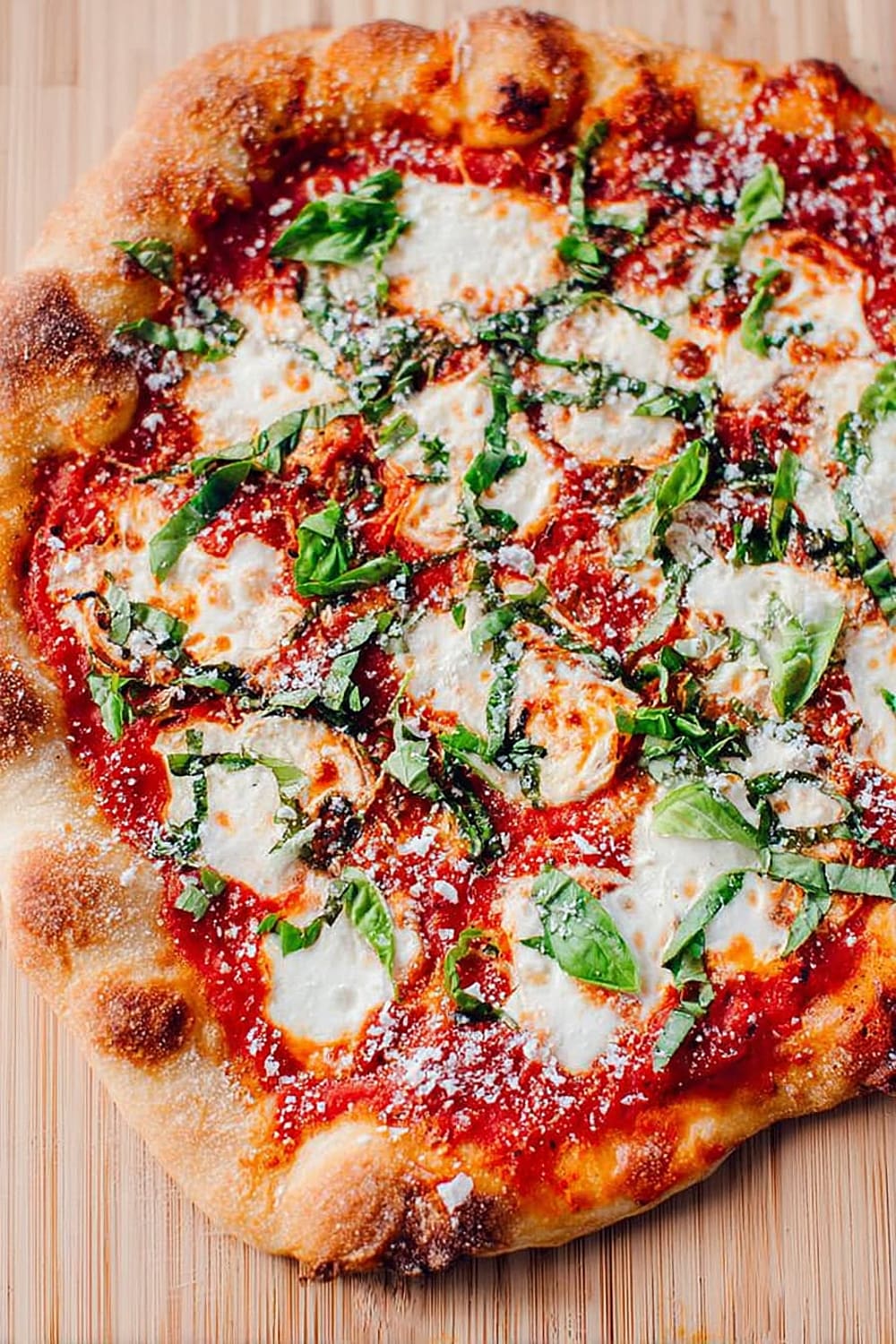
Perfect Pairing Suggestions
Beverage Pairings:
Italian Chianti or Sangiovese complement the tomato and basil beautifully, while Pinot Grigio provides a crisp contrast to the rich mozzarella. For beer lovers, Italian Peroni or light wheat beers won’t compete with the delicate flavors. Non-alcoholic options include sparkling water with lemon, Italian sodas, or fresh lemonade that cuts through the cheese richness.
Side Dish Recommendations:
A simple arugula salad with lemon vinaigrette provides peppery contrast to the mild pizza flavors. Roasted vegetables like zucchini, bell peppers, or eggplant extend the Italian theme while adding fiber and nutrients. Antipasto platters with olives, cured meats, and marinated vegetables create an authentic Italian experience. Garlic bread made from leftover dough rounds out the carb-forward meal.
Complete Meal Ideas:
Start with bruschetta or caprese skewers as appetizers that echo the pizza’s tomato-basil theme. Follow the pizza with tiramisu or gelato for an indulgent Italian feast. For casual entertaining, serve alongside Caesar salad and roasted vegetables. Family-style presentation works beautifully with multiple pizza varieties and shared salads.
Occasion Suggestions:
Perfect for weekend family dinners, casual date nights, or pizza parties where guests can customize toppings. Summer entertaining benefits from the fresh basil and tomatoes, while winter comfort food cravings are satisfied by the warm, cheesy satisfaction. Game day gatherings and movie nights become more sophisticated with homemade pizza.
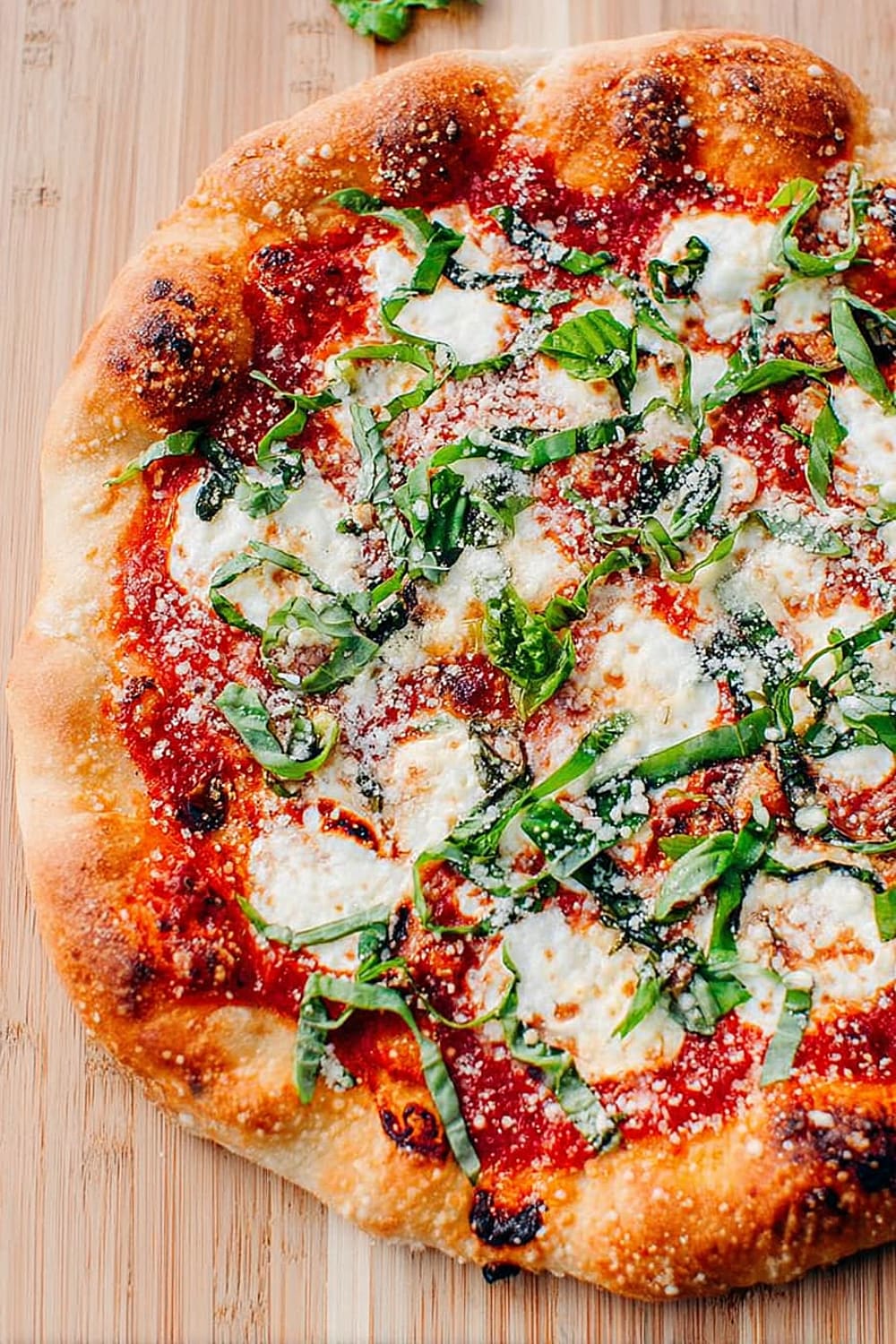
Pro Tips and Troubleshooting
Professional Techniques:
Room temperature ingredients mix more easily and create better dough texture – take eggs and dairy out 30 minutes early. Stretch dough from the center outward using gravity and your knuckles rather than rolling pins, which push out air bubbles. Less is more with toppings – overloaded pizzas create soggy centers and uneven cooking. Preheat your serving plates in the warm oven for 2-3 minutes to keep pizza hot longer.
Common Mistake Prevention:
Dough springs back during stretching means gluten needs more rest time – cover and wait 10 more minutes. Soggy pizza centers result from too much sauce or wet mozzarella – pat cheese dry and use sauce sparingly. Burnt edges with raw centers indicate oven temperature too high – reduce by 25°F and bake longer. Pizza sticking to peel happens with insufficient semolina – shake the peel frequently during assembly.
Storage and Make-Ahead Strategies:
Prepared dough keeps 3 days refrigerated or 3 months frozen – thaw overnight in refrigerator before using. Par-baked crusts can be frozen for 2 months and topped/finished later for quick meals. Leftover pizza reheats best in a cast iron skillet with a lid for 3-4 minutes to crisp the bottom while melting the cheese. Pizza sauce keeps 1 week refrigerated and 6 months frozen.
Scaling and Presentation:
Double recipes easily but mix dough in batches if your bowl is small. Half recipes work but may affect rise time – check after 90 minutes. Garnish immediately after baking while cheese is still melty. Cut with kitchen shears for cleaner slices than pizza wheels on thin crusts.

This homemade margherita pizza proves that restaurant-quality results are absolutely achievable in your home kitchen with the right techniques and a little patience. The combination of properly fermented dough, quality ingredients, and intense oven heat creates those coveted crispy-yet-chewy textures and bubbling, caramelized cheese that make every bite memorable. Whether you’re impressing dinner guests or treating your family to something special, this recipe delivers consistent, delicious results that’ll have everyone asking for your secret – and now you have one worth sharing.